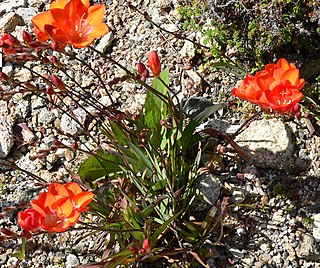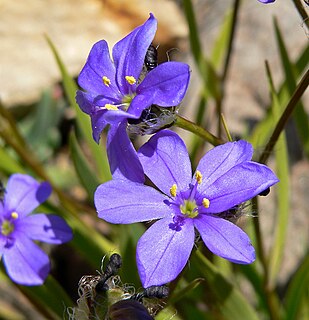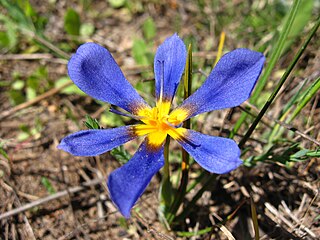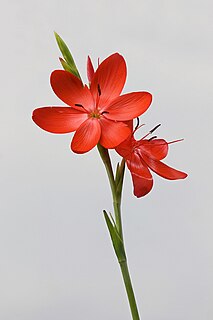
Sparaxis is a genus of flowering plants called the harlequin flowers. It belongs to the iris family Iridaceae with about 13 species endemic to Cape Province, South Africa.

Freesia is a genus of herbaceous perennial flowering plants in the family Iridaceae, first described as a genus in 1866 by Christian Friedrich Ecklon (1886) and named after the German botanist and medical practitioner, Friedrich Freese (1795-1876). It is native to the eastern side of southern Africa, from Kenya south to South Africa, most species being found in Cape Provinces. Species of the former genus Anomatheca are now included in Freesia. The plants commonly known as "freesias", with fragrant funnel-shaped flowers, are cultivated hybrids of a number of Freesia species. Some other species are also grown as ornamental plants.

Gladiolus is a genus of perennial cormous flowering plants in the iris family (Iridaceae).

Babiana is a genus of flowering plants in the family Iridaceae composed of about 80 recognized species. The majority of these species are endemic to the Cape Provinces of South Africa, especially Namaqualand, as well Namibia, Botswana, Zambia and Zimbabwe.

Ixia is a genus of cormous plants native to South Africa from the family Iridaceae. Some of them are known as the corn lily. Some distinctive traits include sword-like leaves and long wiry stems with star-shaped flowers. It usually prefers well-drained soil. The popular corn lily has specific, not very intense fragrance. It is often visited by many insects such as bees. The Ixia are also used sometimes as ornamental plants.

Watsonia is a genus of plants in the family Iridaceae, subfamily Crocoideae. Watsonias are native to southern Africa. The genus is named after Sir William Watson, an 18th-century British botanist.

Tritonia is a genus of flowering plants in the iris family first described as a genus in 1802. They are naturally distributed across southern Africa, with a high concentration of species in Cape Province of western South Africa. The genus is closely related to the genus Ixia.

Moraea, the Cape tulips, is a genus of plants in the family Iridaceae, first described as a genus in 1758. The group is widespread across Africa, the Mediterranean, and central and southwestern Asia. The genus name is a tribute to the English botanist Robert More.

Romulea is a genus of flowering plants in the family Iridaceae, first described as a genus in 1772. It is distributed in Europe, the Mediterranean, the Arabian Peninsula, and Africa.

Aristea is a genus of evergreen, perennial and rhizomatous species of flowering plants in the family Iridaceae, first described in 1789. The genus is distributed in tropical and southern Africa, as well as Madagascar. The genus name is derived from the Greek word arista, meaning "awn".

Calydorea is a small genus of perennial, herbaceous and bulbous plants in the family Iridaceae native to Mexico and South America. The plants in the genus are small with tunicated bulbs. The flowers are light blue, violet, white, or yellow, depending on the species, of which there are around twenty. Taxonomists considered that the already known genera Salpingostylis, Cardiostigma, Catila and Itysa are not enough different from each other to justify their taxonomic segregation and, for this reason, all of them are now included in Calydorea.

Hesperantha is a genus of cormous flowering plants in the family Iridaceae. The genus name is derived from the Greek words hesperos, meaning "evening", and anthos, meaning "flower".

Nivenia is a genus of flowering plants in the family Iridaceae first described as a genus in 1808. Species in the genus are restricted in distribution to an area in the Cape Province of South Africa.
Thereianthus is a genus of flowering plants in the family Iridaceae, first described as a genus in 1941. The entire genus is endemic to Cape Province in South Africa.
Iris dolichosiphon is a plant species in the genus Iris, it is also in the subgenus Iris and in the section Pseudoregelia. It is a rhizomatous perennial, from China and Bhutan. It has long, thin dark green leaves, very short stem, and dark blue, purple, or violet flowers. That are mottled with white. It has thick white/orange beards. It has one subspecies, Iris dolichosiphon subsp. orientalis, from China, India and Burma. It has similar flowers. They are cultivated as ornamental plants in temperate regions

Romulea tortuosa is a herbaceous perennial geophyte in the family Iridaceae native to South Africa. It has a small corm in the soil, a few prostrate coiling leaves, and fragrant, trimerous yellow flowers, sometimes with six brown blotches on the inside near the bottom of the flower.














